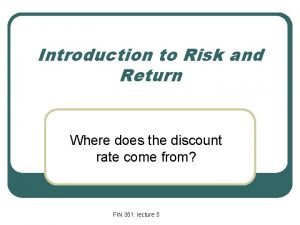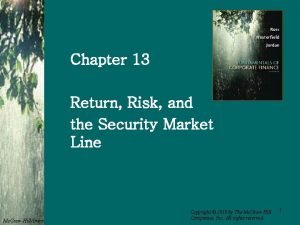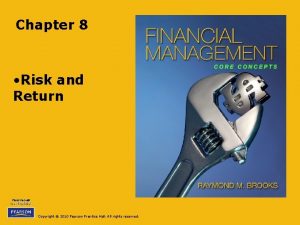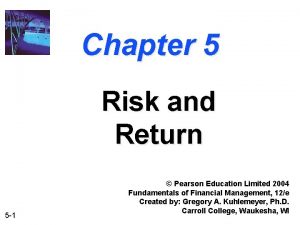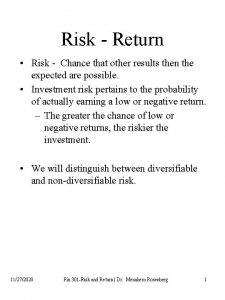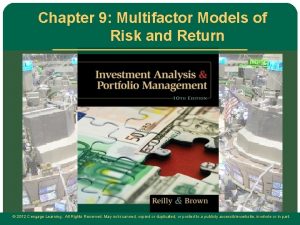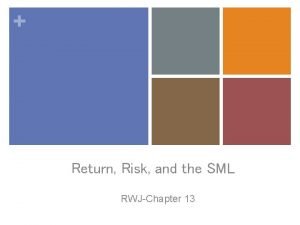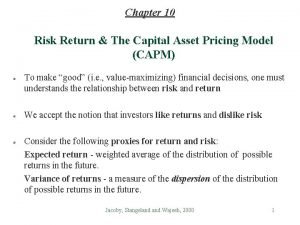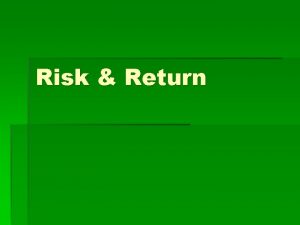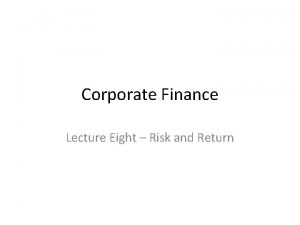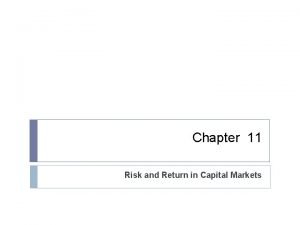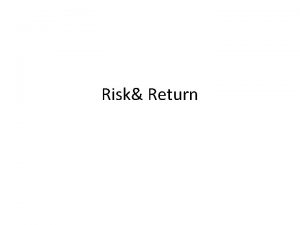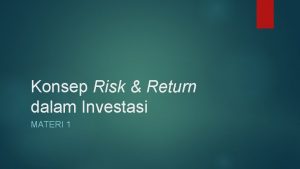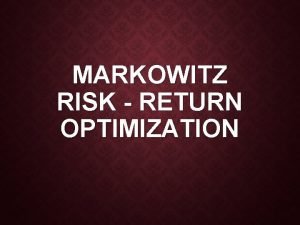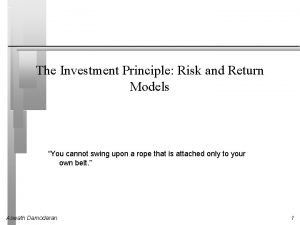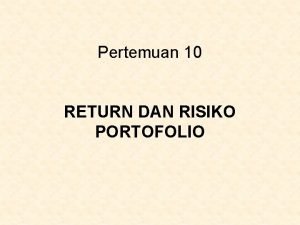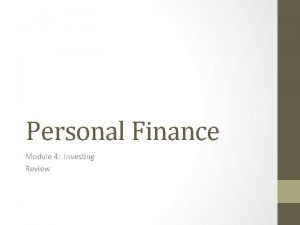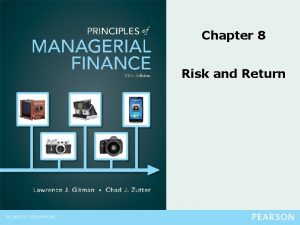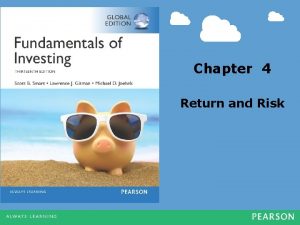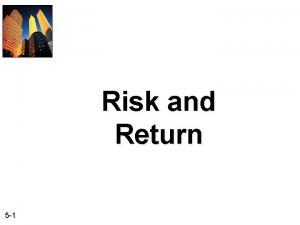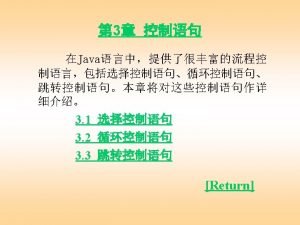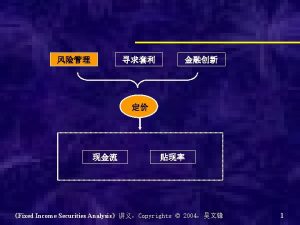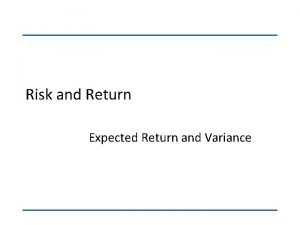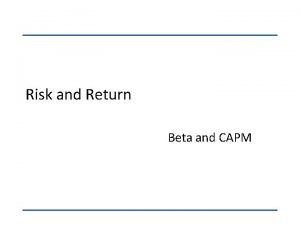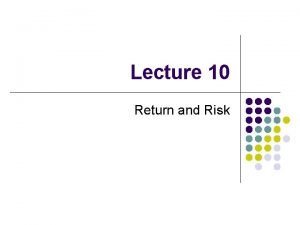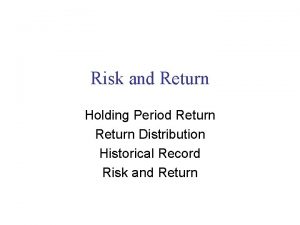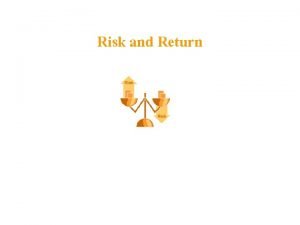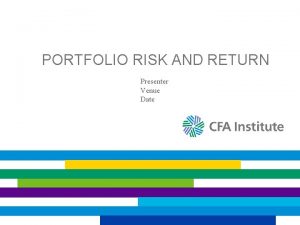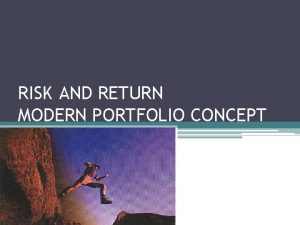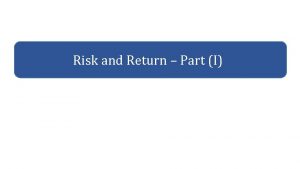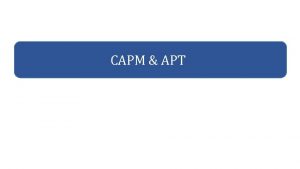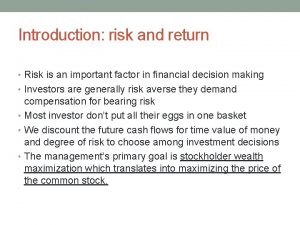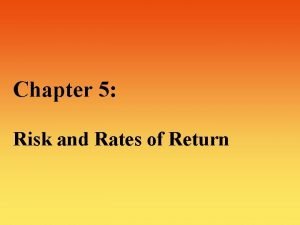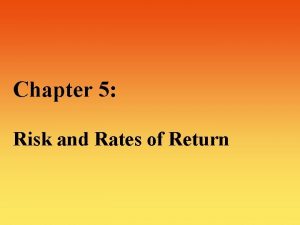Risk and Return Introduction Chapter 9 For 9




















- Slides: 20

Risk and Return – Introduction Chapter 9 For 9. 220,

Introduction o o It is important to understand the relation between risk and return so we can determine appropriate risk-adjusted discount rates for our NPV analysis. At least as important, the relation between risk and return is useful for investors (who buy securities), corporations (that sell securities to finance themselves), and for financial intermediaries (that invest, borrow, lend, and price securities on behalf of their clients).

What is risk? o o Definition: risk is the potential for divergence between the actual outcome and what is expected. In finance, risk is usually related to whether expected cash flows will materialize, whether security prices will fluctuate unexpectedly, or whether returns will be as expected.

Unless otherwise indicated, the word “return” refers to % returns (either in % or decimal form). Measuring Performance: Returns o Dollar return (over one period): = Dividends + End of Period Price – Beginning of Period Price o Percentage return (over one period): =Dollar return/Beginning of Period Price =(Dividends + End of Period Price)/Beginning of Period Price -1 q Dividend at Notating Percentage Returns time =t Dividend yield Capital gain yield

Historic returns - Example 1 Q. Suppose a stock had an initial price of $42 per share, paid a dividend of $0. 84 per share during the year, and had an ending price of $46. 2. Calculate: a. Percentage total return b. Dividend yield c. Capital gains yield

Returns - Example 1 Dividends = $0. 84 Ending Market Value = $46. 20 Time: t - 1 Outflows – $42. 00 Total inflows = $47. 04 t

Historic returns - Example 1 A. a. percentage total return Find R? ? ? b. Find dividend yield ? ? c. Findcapital gains yield = ? ? ?

Returns u Holding Period Return HPR = (1 + R 1)(1 + R 2). . . (1+ RT) -1 u (Geometric) Average Return GAR = [(1 + R 1)(1 + R 2). . . (1+ RT)]1/T -1 = [1 + HPR]1/T -1 u (Arithmetic) Average Return

Historic returns - Example 2 Q. The following are TSE 300 returns for the 1994 -1997 period: Year (t) 1994 1995 1996 1997 Return (Rt) -0. 18% 14. 53 28. 35 14. 98 Calculate: a. holding period return (HPR) b. geometric average return (GAR) c. arithmetic average return (R)

A. Historic returns - Example 2 a. holding period return _______ b. geometric average return _____ c. arithmetic average return (mean) R(bar) =______

The risk premium o Definition: the risk premium is the return on a risky security minus the return on a risk-free security (often T-bills are used as the risk-free security) n o o Another name for a security’s risk premium is the excess return of the risky security. The market risk premium is the return on the market (as a whole) minus the risk-free rate of return. We may talk about the past observed risk premium, the average risk premium, or the expected risk premium.

Risk measures o o Studies of stock returns indicate they are approximately normally distributed. Two statistics describe a normal distribution, the mean and the standard deviation (which is the square root of the variance). The standard deviation shows how spread out is the distribution. For stock returns, a more spread out distribution means there is a higher probability of returns being farther away from the mean (or expected return). For our estimate of the expected return, we can use the mean of returns from a sample of stock returns. For our estimate of the risk, we can use the standard deviation or variance calculated from a sample of stock returns.

While return measures reward, we need some Do you see evidence measure of uncertainty (variability) associated risk? return with of that The average Risk Premium for Common Stocks in Canada from 1948 to 1997 was 7% Source: William M. Mercer Ltd.

Other return statistics u u Historic Return Variance: Average value of squared deviations from the mean. A measure of volatility. Historic Standard Deviation: Also measures volatility.

Other return statistics - An example u Historic Return Variance: u Historic Standard Deviation: root of variance

Calculating Variance with a Table Expected return Deviation from Mean Squared Deviation -------------------------------- _______________________ Mean = ____ Divide sqd dev with (n-1) to get ______ Then Find _____

How to interpret the standard deviation as a measure of risk o Given a normal distribution of stock returns … n n n there is about a 68. 26% probability that the actual return will be within 1 standard deviation of the mean. there is about a 95. 44% probability that the actual return will be within 2 standard deviations of the mean. There is about a 99. 74% probability that the actual return will be within 3 standard deviations of the mean.

Using Return Statistics The Normal Distribution (based on TSE 300 1994 -1997 return data) Probability Prob. (r < -8. 90% OR r > 37. 74%) = 4. 56% 68. 26% Prob. (-8. 90% r 37. 74%) = 95. 44% >99. 74% m – 3 s - 20. 56% m – 2 s - 8. 90% m –s + 2. 76% m + 14. 42% m +s + 26. 08% m + 2 s + 37. 74% m + 3 s Return on + 49. 4% TSE 300 stocks

U. S. Historical Return Statistics Series Arithmetic mean U. S. Common stocks Long-term U. S. corporate bonds Long-term U. S. government bonds U. S. Treasury bills Risk premium (relative to U. S. Treasury bills) Arith Mean Risk Premium 13. 0% 9. 2% 6. 1 5. 4 3. 8 2. 3 Standard deviation Standard Deviation 20. 3% -90% 0% 90% 8. 7 1. 6 5. 7 0 -90% as risk 0% Note: increases, so does the excess return 3. 2 on a risky asset -90% 0% 90% Modified from Stocks, Bonds, Bills and Inflation: 1998 Yearbook, TM annual updates work by Roger C. Ibbotson and Rex A. Sinquefield (Chicago: Ibbotson Associates). All rights reserved.

Summary and conclusions o o o We can easily calculate $, %, holding period, geometric average, and mean returns from a sample of returns data. We can also do the same for a security’s risk premium. The mean and standard deviation calculated from sample returns data are often used as estimates of expected returns and the risk measure for a security or for the market as a whole.
 Introduction to risk and return
Introduction to risk and return Financial management chapter 8 risk and return
Financial management chapter 8 risk and return Chapter 13 return risk and the security market line
Chapter 13 return risk and the security market line Chapter 8 risk and rates of return problem solutions
Chapter 8 risk and rates of return problem solutions Chapter 5 risk and return
Chapter 5 risk and return Market risk credit risk operational risk
Market risk credit risk operational risk Risk and return
Risk and return Risk and return
Risk and return Risk and return
Risk and return Multifactor model of risk and return
Multifactor model of risk and return Risk and return
Risk and return Capital market line
Capital market line Contoh soal risk and return
Contoh soal risk and return Difference between risk and return
Difference between risk and return Difference between risk and return
Difference between risk and return Risk and return
Risk and return Konsep risk and return
Konsep risk and return Markowitz model of risk return optimization
Markowitz model of risk return optimization Risk return principle
Risk return principle Return portofolio adalah
Return portofolio adalah The basic rule of a risk-to-return relationship is that the
The basic rule of a risk-to-return relationship is that the
